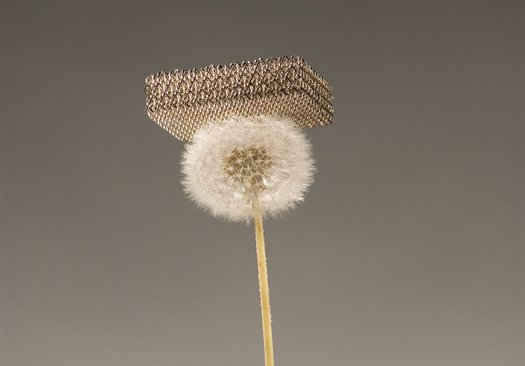When it comes to light weight materials, the first thing that comes to our mind is Thermocol. Since its discovery in the year 1941, it has been used in many applications that are suitable for the common man like small life raft, disposable coffee cups, cushioning material in packaging, and so on. Since then, the weights of most light weight materials are compared to Thermocol, and have been given a special category called Ultra-light materials. A team of researchers from HRL Laboratories (Hughes Research Laboratories), in collaboration with Caltech and the University of California, developed a new material that weighs only 1/100th of the weight of Thermocol. The material is also known o be lighter than a diamond aerogel, one of the best ultra-light materials in the world. Before going into detail about the lightest material, let us make a brief study about diamond aerogels.
Diamond aerogel was discovered by researchers at the Lawrence Rivermore National Laboratory by combining high density diamond substances and least dense materials called aerogels. Aerogel is known to be a porous, diffuse rigid material that looks similar to a solid block of smoke and with the texture of a chunk of thermocol. They are industrially manufactured by constructing a conventional gel and then removing the liquid though supercritical drying. The material finds various applications in the making of insulate space suits, pick up cosmic particles, and even home insulation.
The combination of both the materials gave birth to a spongy, translucent version of a diamond. This material when tested was found out to be the least dense diamond ever, and thus the most expensive aerogel ever. They called it a diamond aerogel, definitely the least dense diamond ever and perhaps one of the most valuable aerogels ever. The material was found to be a little denser than air and has all the physical capabilities of a non-liquid gel component. This material also found many applications in the field of structural engineering, optical engineering, and quantum computing and so on.
The lately found ultra-light material has a density of 0.9 mg/cc, and is known to have its own unique kind of “micro-lattice” cellular architecture. The researchers were successful in making a material that consists of 99.99% open volume by designing the 0.01% solid at the nanometer, micron and millimetre scales.
The material was developed for DARPA so that it could be used for applications in battery electrodes, catalyst supports, vibration or shock energy damping applications and so on. The material has shown excellent mechanical behaviour for a metal, including complete recovery from compression exceeding 50% strain and extraordinarily high energy absorption, when compared to its compact architecture.
This discovery has led the researchers to bring in more ideas to revolutionalize lightweight materials by using this concept to the materials level and designing their architectures at the nano scale.


Comments are closed.